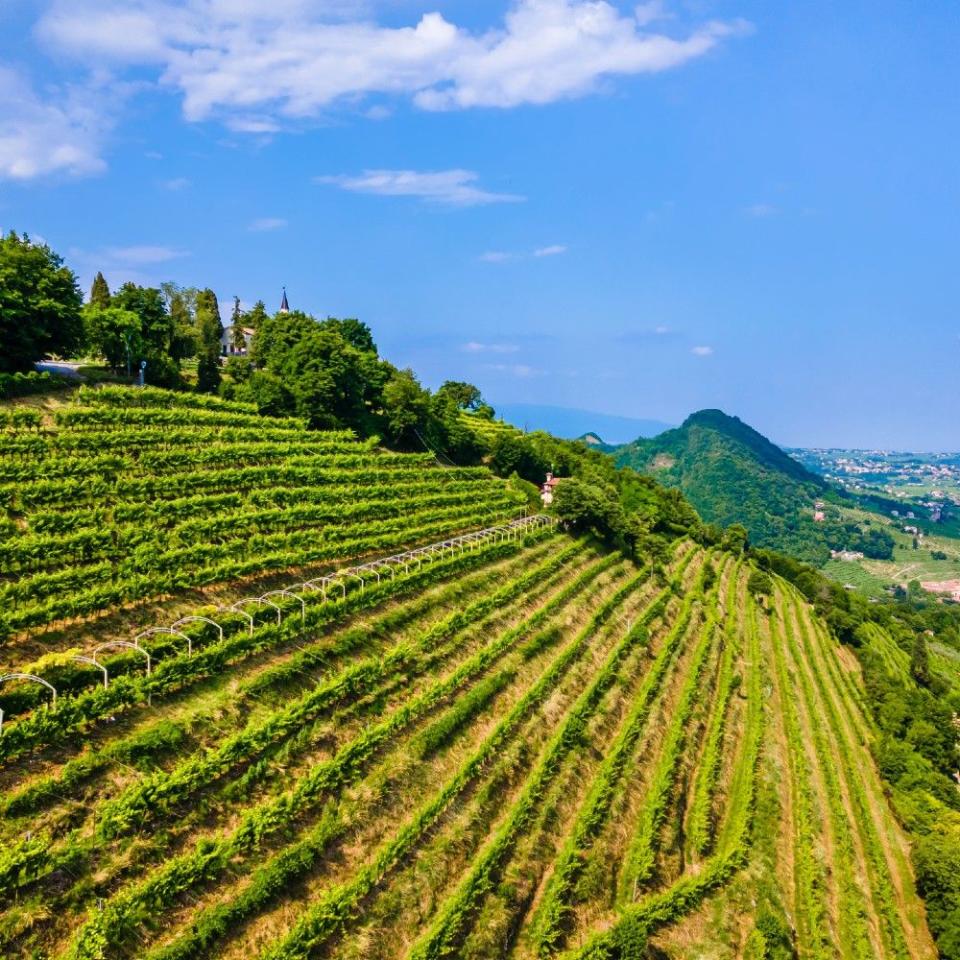Prosecco Isn't "Basic" And More Facts

Prosecco: the affordable fizz, the easy-drinking version of champers, and truly the drink of the people.
While it’s commonplace on supermarket and corner shop shelves, restaurant and bar menus and let’s be honest in lots of our fridges right now, Prosecco can often be overlooked as “basic.”
But there’s loads to love about the wallet-friendly fizz, and our myth-busting guide is here to help you learn everything there is to know about one of Italy’s most popular liquid exports.
First up, what is Prosecco?
Let’s go back to basics: Prosecco is a sparkling wine made in Northern Italy. It’s made from the Glera grape grown on steep hills in the Italian provinces of Veneto and Friuli and is known for its easy-drinking nature (which you’ll know about if you’ve ever been to a bottomless brunch…) and affordability. It comes in varying levels of sweetness and fizziness, as well as different quality levels depending on where the grapes are grown.

Are all Proseccos the same generic sparkling wines?
Absolutely not! While we all love a cheap and cheerful bottle from the local shop, there are bottles of Prosecco that are super-high quality too. You’ll see DOC Prosecco written on the bottles of all kinds, but the DOGC Prosecco from – now bear with us, the name is long - Conegliano Valdobbiadene Prosecco Superiore is the very best out there. Bottles with this labelling have been made from grapes grown in Conegliano Valdobbiadene, a beautiful UNESCO World Heritage site with steep slopes where the grapes are hand harvested from.
How is Prosecco made?
Prosecco is made by fermenting Glera grapes to create wine, and then fermenting the wine a second time in a steel tank using something that’s known as the Charmat method. This is what causes the wine to become a sparkling wine and creates those lively bubbles. The wine is then bottled and shipped to your fave Prosecco outlet for you to buy. Some wines are laid down in cellars and aged to allow them to develop more complex flavours, but the nature of the Glera grape and the tank production method of making Prosecco means that it’s designed to be drunk young and fresh – so no waiting around saving it for best!
What does Prosecco taste like?
You’d be hard pressed to find someone who’s not had a sip of Prosecco at a big celebration, but if you didn’t already know, Prosecco usually tastes fresh and fruity with lots of citrusy notes. You’ll sometimes get notes of pear and apple too. It’s sweeter than other drinks like Cava and Champagne, but it’s still got freshness that makes it easy to drink, especially alongside food.

Is Prosecco always fizzy?
Although most of the bottles you’ve had the pleasure of drinking will have been sparkling ones, you can actually get two different kinds of sparkling Prosecco, as well as a rarer still kind. Spumante Prosecco is the usual type, with lots of bubbles and serious fizz, whereas Frizzante is more gently sparkling, and Tranquillo (great name) is totally still.
Is Prosecco the same as Champagne?
No! Aside from the massive difference in price tag (even the cheapest bottles of champers cost around £15) the grapes they’re made from and the way they’re made is totally different. Champagne is usually made with Chardonnay, Pinot Noir or Pinot Meunier grapes and can only be produced in the Champagne region in North-eastern France, whereas Prosecco is made with the Glera grape in Italy. Champagne is also fermented like Prosecco, but the second bubble-causing fermentation takes place in the bottle instead of in a big tank. This is part of what contributes to the higher price tag of Champagne, as well as what causes the more complex flavour of the drink. However, both are delicious and perfectly appropriate at brunch, celebrations or just a Tuesday night on the sofa in front of your favourite film.
Is Prosecco the same as Cava?
Nope. Although both these drinks are budget-friendly sparkling wines, Cava is made in Spain rather than Italy, and has more citrusy notes than Prosecco. It can also taste a little more deep and savoury, which is why it’s often said it’s the best alternative to Champagne as the flavours are more complex than a fresh and fruity Prosecco. The bubbles in Cava are also made using the same method as Champagne – in the bottle.
How do you store Prosecco?
Prosecco is supposed to be drunk soon after it’s made, so there’s no real point in storing it away! Keep it in your fridge or somewhere dark and cool ready to pop open at any moment.
Fancy something different? Here are some Prosecco cocktail ideas
Prosecco is great by itself, but it’s also a brilliant component in cocktails. It’s essential in Spritzes like the Aperol or Hugo Spritz, and in drinks like the Mimosa and Bellini.


